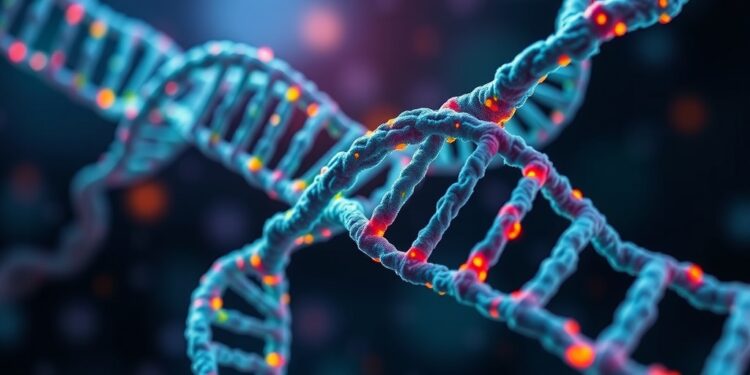Recent advancements in the field of molecular genetics have unveiled groundbreaking insights into the intricate mechanisms of DNA repair processes. A team of researchers from the University of Birmingham has made significant strides in deciphering two critical aspects of DNA repair that have remained elusive for years. This essential work sheds light on how our cellular systems meticulously monitor and rectify DNA damage, which is vitally important not only for cellular health but also for the development of more effective cancer treatments.
Every cell in our body is equipped with a sophisticated network that constantly surveys its genetic material for signs of damage. When the DNA sequence gets compromised—be it through environmental factors, replication errors, or radiation—cells spring into action. Internal signaling pathways are triggered to identify the location and extent of the damage, subsequently recruiting specialized proteins, often referred to as DNA repair "machines." These proteins are tasked with the pivotal role of repairing the DNA strand breakages and restoring genetic integrity. However, this repair process is not simply a matter of fixing the errors; it requires precise regulation to ensure that the correct proteins arrive in the appropriate quantities and sequence for effective repair.
Chemotherapy, a primary weapon in the fight against cancer, predominantly exploits the principle of DNA damage to halt the proliferative abilities of tumor cells. By understanding the complexities of DNA repair, especially the specifics of which proteins are invoked during this process, scientists can begin to refine therapeutic strategies. The hope is that with advanced knowledge of DNA repair mechanisms, new cancer treatments can be devised that are not only more effective but also reduce collateral damage to healthy cells.
In the first of two pivotal studies released in the journal Nature Communications, researchers identified a previously uncharacterized regulatory mechanism, termed a "twisting switch." This mechanism plays a crucial role in modulating early repair signals, ultimately aiding in the delicate orchestration of DNA repair. By manipulating the shapes of proteins, the twisting switch effectively turns off these early signals at the right time to avoid prolonged activation that could disrupt the entire repair process.
The twisting switch specifically targets RNF168, a DNA repair protein known for its propensity to induce uncontrolled signaling. The research describes a four-step mechanism that facilitates the removal of RNF168 from chromatin, which is essential for circumventing excessive DNA damage signals. Without this meticulous regulation, cells become hypersensitive, particularly to radiation, highlighting the importance of this new discovery in preventing excessive signals that can block effective DNA repair.
The second study, published in the journal Molecular Cell, further underscores the intricacies of DNA repair mechanisms by exploring the role of a once-underappreciated protein named SUMO4. The research revealed that SUMO4 has a significant role in preventing the overload of DNA damage signals within the cell. In situations where SUMO4 is absent, cells display an excess of certain signaling types, which disrupts the balance necessary for effective DNA repair. This work challenges previous assumptions and opens new avenues for research into the role of SUMO4 and its potential implications for cancer therapies.
The significance of these research findings lies not only in their scientific merit but also in their potential to transform the way we approach cancer treatment. Improved understanding of the molecular players involved in DNA repair could lead to innovative therapeutic strategies that bolster existing chemotherapy regimens or pave the way for the development of new drug targets aimed at enhancing DNA repair pathways.
As we stand on the cusp of a new frontier in cancer treatment, the implications of these studies extend far beyond academic curiosity. The integration of molecular genetics insights into clinical oncology could revolutionize treatment regimens that presently lead to undesirable side effects, offering patients a better quality of life and more efficient disease management.
While the path of research is fraught with challenges and uncertainties, these discoveries serve as a testament to the power of scientific inquiry. Each finding contributes to a growing body of knowledge that elucidates how our cells navigate the complexities of genetic repair and maintenance. Moving forward, collaborative efforts within the scientific community will be crucial to translating these discoveries into practical applications that enhance patient care.
In summary, the work from the University of Birmingham represents a significant advance in our understanding of DNA repair mechanisms. By elucidating the roles of novel regulatory proteins and mechanisms, this research not only fills in gaps in our knowledge but also inspires hope for improved cancer therapies in the future. As we continue to explore the machinations of the molecular world, the potential to unlock new treatments becomes ever more tangible.
Subject of Research: DNA repair mechanisms
Article Title: PIN1-SUMO2/3 motif suppresses excessive RNF168 chromatin accumulation and ubiquitin signaling to promote IR resistance
News Publication Date: April 14, 2025
Web References: Nature Communications DOI
References: Not applicable
Image Credits: Not applicable
Keywords: DNA damage, DNA repair pathways, genomic DNA, cancer genome sequencing, chemotherapy, tumor growth.




